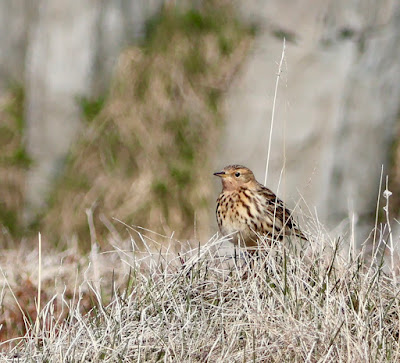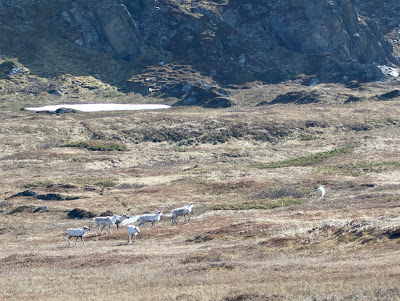Our second stop on the morning of May 30th was Kjølnes Lighthouse in Norway. It was gray, cold and windy. From this point forward I am no longer going to write that it was windy. In coastal Norway, it is windy - all the time. Not just a mild, ocean breeze. No, gusty, cold wind. I had to face it; we were above the Arctic Circle. We did get a lucky break from the wind, once, which I'll write about later.
Both of our guides had Swarovski spotting scopes and these served us well throughout the trip. We received instructions on spotting scope etiquette at the start of the trip, but these were forgotten at the first opportunity. I noticed also that many, including myself, were squeamish about moving or focusing the scope. I felt like I couldn't touch the scope. I'm not sure how valuable a sea watch is under such conditions. Gray skies, gray water and wind. If something good was seen by the guides, (one trip participant described it as, "looking at dots over the water") it meant that twelve people had to line up behind the scopes for their own look. This also meant that the dot on or over the water was most often long gone by the time, say, the third or fourth in line got their turn. I stuck with this as long as I could stand it. It's my least favorite way to see birds (tied with looking through dirty van windows). If it's a life bird I'll certainly give it a try, but I typically don't see the bird well enough to count it anyway. This is true even for a trip bird. We had three sea watches under these conditions - the very last one was probably the absolute worst. In my view, in addition to wasting time, activities like this probably pad the trip species list more than anything else. I know many will disagree.
Fortunately this was also lunch time; on this day, bagged lunches. I got my bag, made a cup of coffee and left the lighthouse to find a place to eat out of the wind. I never returned.
After lunch my wandering took me around to the other outbuildings and a landscape which was either rocky or grassy little hills. Away from the lighthouse the wind was diminished and it was very pretty especially around the little hills.
Common Ringed Plover (Charadrius hiaticula) - seen often on this trip.
Above and below: Red-throated Pipit (Anthus cervinus).
Anttu said that we were also looking for a Rock Pipit here for one of the trip members who needed it as a life bird. My solo wondering scared up a pipit - I could tell by the way it was acting and flying - but it never settled to get a real look. I thought it was a Rock Pipit (A. petrosus). When everyone finally came down from the lighthouse I told Anttu that there was a Rock Pipit flying around in the grassy hills. "Oh, let's find it." He played the Rock Pipit vocalization and the bird that revealed itself was a Red-throated Pipit. I had never seen a Rock Pipit or a Red-throated Pipit so I was pleased with either. But, I was told that Red-throated Pipit was "so much better" because they are harder to find. True enough, both birds have a very slender range along the coastlines. We did later see a Rock Pipit - just one - and we also saw Red-throated Pipit at least once again after this.
Believe it or not, the photo above is a different photo than the first.
Out-of-focus! I loved this photo and I missed.
Nothing was ever said about seeing Red-throated Pipit on this trip. I feel about pipits like I feel about wagtails. We don't have enough of them; for me, American Pipit (A. rubescens) is really the only one possible. I've never seen Sprague's Pipit (A, spragueii) out west, despite seriously looking on a trip across Montana in June 2009. The Red-throated Pipit's range in Alaska is a mere decimal point* when compared with the range of, say, the Gray-headed Chickadee* - oops, I mean Siberian Tit.
On the list of my five favorite trip birds, I tied Ortolan Bunting and Red-throated Pipit in the fifth spot. Maybe Red-throated Pipit should have been all by itself. So much second guessing.
Landscape along the road leaving the lighthouse.
Coastal Norway's landscapes are beautiful and quite dramatic. Enlarge this photo to see the reindeer in the lower center left.
Addendum 07/25/2025
* The July 2025 edition of the ABA Birding magazine (Vol 57, No 4, pages 30-45) published an article suggesting that Gray-headed Chickadees may be extirpated from North America - both Alaska and NW Canada. They have not been seen since 2018. It's a good and extensive article; it's a sad article. Undoubtedly, the search will continue and, hopefully, Gray-headed Chickadees will be relocated. After all its range is vast! But, this also makes my statement above completely false. When I wrote mere decimal point above, this article had not yet been published. Instead, I was trying to make a birding-style joke about the disputed name Gray-headed Chickadee that I write about in my Siberian Tit post. (The range of Red-throated Pipit is indeed a decimal point in NW Alaska. That part is still true.)
I would post a link to the article, titled Lost on the Frontier by Brad Meiklejohn, but having already posted it elsewhere, I know that non-ABA members are unable to access it. If interested, and I highly recommend it, you may be able to find it on the newsstand of your local bookstore, or at your local library. There is a photo of Loggerhead Shrike on the cover. Finally, you can always join the American Birding Association. It's a good organization and its monthly magazine has gotten better.
The last birds to have disappeared from the US are Eskimo Curlew and Bachman's Warbler, both last seen in the early 1960s and both now believed to be extinct. The last confirmed Eskimo Curlew sighting was in Galveston, Texas in 1961, and the last Bachman's Warbler sighting was of a singing male in I'on Swamp near Charleston, South Carolina in 1962.
The article mentions Aplomado Falcon (Falco femoralis) and Thick-billed Parrot (Rhynchopsitta pachyrhyncha) as analogs to the chickadees (page 44), but both are still present in good numbers in adjacent Mexico and it is conceivably possible for either to re-establish in the US. In fact, Thick-billed Parrot had been given some help and seems to be hanging on as a breeder and Aplomado Falcon has also been occasionally seen.










No comments:
Post a Comment